



| Interviews: Q. R. Ghazala - Behind the Circuit Bending Posted on Monday, April 30 @ 11:41:27 CDT by ecookContributed by: ecook |
| We're very happy to unveil our
first interview here on Allsound, and especially happy that the interview
is with musical and visual artist Q.
R. Ghazala. Best known as the founder of the art of circuit bending,
the creative shortcircuiting of existing instruments, toys and electronic
devices (which can produce beautiful and unexpected sonic results),
Ghazala has written extensively on both the practical and theoretical
aspects of this art.
Ghazala graciously agreed to an indepth discussion with us via email,
and has also supplied us with a wide variety of illustrative images. Read
on for the full interview, where we discuss the context of Ghazala's work,
the interactions between disciplines, artists, machines, composition and
much more. (Lo-bandwidth readers may want to read the image-free
version.) |
 Q.
R. Ghazala is a self-taught, self-described exile and recluse who has been
making music, instruments and art for over 30 years. During this time,
he's built instruments for Faust, Chris Cutler, Towa Tei, Yann Tomita, Tom
Waits, and many others, and his art has become part of the NYC Museum of
Modern Art, the Guggenheim and the Whitney permanent collections. He's
recorded and released numerous tapes and CDs, and written an acclaimed
series of circuit-bending articles for Experimental
Musical Instruments magazine. For more information, Ghazala's anti-theory.com
site features a full bio, as
well as plenty of additional information on the subjects covered in this
interview, and many more images of his instruments and art Q.
R. Ghazala is a self-taught, self-described exile and recluse who has been
making music, instruments and art for over 30 years. During this time,
he's built instruments for Faust, Chris Cutler, Towa Tei, Yann Tomita, Tom
Waits, and many others, and his art has become part of the NYC Museum of
Modern Art, the Guggenheim and the Whitney permanent collections. He's
recorded and released numerous tapes and CDs, and written an acclaimed
series of circuit-bending articles for Experimental
Musical Instruments magazine. For more information, Ghazala's anti-theory.com
site features a full bio, as
well as plenty of additional information on the subjects covered in this
interview, and many more images of his instruments and art |
| [ed. note - this interview
took place between March and April of 2001. Eric Cook's questions are
numbered, and appear in italics; Ghazala's answers appear in normal text.
A list of selected links follows the article.]
Discipline Interactions: 1) You work in multiple disciplines (music, instrument building, painting, photography, and so on); how do you feel that your various types of art interact with each other? I often explore the Never-Never Lands of these disciplines. In electronics it's primarily musical circuit-bending though the same principles of chance design can be equally applied to electro-lumia. Disturbed video feeds, cold light and plasmas, things like this. That's how I made my first plasma display over thirty years ago... without instructions, exploring a Never-Never Land. These chambers weren't tabletop art back then. Closest thing was probably in the medical field -- descendants of the Royal Rife era of plasma devices perhaps. I did this by means of blindly experimenting with an antique "Violet Ray Generator". This is a medical device that bombarded plasma contained within various glass tubes with high-frequency electricity, causing the gasses to glow. I found that if I attached the Violet Ray electrode to the base of an enormous tungsten stadium lamp that the atmosphere within the bulb's glass envelope would immediately become filled with arching discharges and ethereal violet haze. This display simply amazed people back then, decades before plasma displays were introduced commercially. It was a Never-Never Land at that time.
 Ghazala's early plasma display In photography it might be home-built lenses and filters, modified cameras and outdated films, macro stereo imaging with paired cameras, or better yet, the exploration of the dye-migration process, the "instant print" technology behind Polaroid integral films... While much fine work has been done here involving post-camera film manipulations in which the newly-ejected Polaroid photograph is distorted in various ways, I naturally wondered what could be done pre-camera. Without camera in fact, knowing that the individual film sheets contained possibilities of intense color, subtle shadings and near-molecular detail. The resulting experiments within this photographic Never-Never Land were fantastic! Back in the early 1980's I assembled a 160-image show, lap-dissolved via home-built opposite-positioned slide-dimmers controlling now-isolated slide projector bulbs, and timed to Harry Partch's Delusion of the Fury. The show brought much good feedback. You can see other visual experiments on-line at anti-theory.com.
New materials inspire new thoughts. An experimental edge always exists at the forefront of the arts and sciences... what we have and how we use it. How we think about it. What it suggests beyond what it reveals. Art and science tangle here, building a resurgent crest that the renaissance artist-scientist will ride. Beyond material applications (technical discoveries at times shared between these different disciplines) there is furthered in the mind a notion, anti-theory at its best, that locked doors are meant to be questioned, that common theories too often close subjects that only accidental technology and serious theoretical doubt can open. In this way I believe each pursuit of "bent" art fortifies the next, opening a personal, and very tangible, discipline of thought. If my email is an indication, there are a lot of bendillists among us. 2) Does your work in these various disciplines (tool/instrument creation, music/audio art, visual art) operate in parallel, or does one portion drive another? (i.e., Do you feel that your instrument building is in service to your recording/composing, or are the recordings a byproduct of the instrument design?) These are very intense subjects since they look to the strongest drives in expression, a personal sacrifice of everything in order to gain... what? Often only a small object that communicates a viewpoint. An art piece. With the whole of the person's life and experience driving it, every moment that made them reflected in this item. I see artworks in this way, like a mushroom popping up in the forest, and I wonder about the mycelia of the mushroom, the root system, that spreads underground forever, forever out of sight. A communication so beyond technique is here, though we have only the item to see. Like a leaf gall... obvious, expressive, but by nature concealing. A map, a code, a puzzle. In my own work the creative process, how it unfolds, is spontaneous, driven by the revelation of the moment-to-moment process. Music might inspire an instrument design or visa-versa; an illustration process might end up as an instrument finish, a finishing element on an instrument might inspire a silent kinetic art piece. For instance, to underline the prospect of vision (and its various implications), I incorporate fine eyes into many instruments. These eyes might serve as pilot lights -- power lamps, peak meters and program indicators. Or as light sensors for instrument control. The Three-Eyed Photon Clarinet's eyes are both. The central eye, a medical-quality glass human eye, glows blue with power-up and also strobes red at volume peaks. The lateral animal eyes, fine glass and within cabled extensions, are light sensors. The musician waves hands in space above these two eyes to play the instrument.
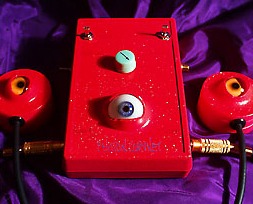 3-Eye Photo Clarinet I mount these eyes by distorting the plastic. The resulting effect is that of an organic growth... the eye seems to have evolved within the instrument. But this system of eye-mounting has now escaped the instruments. Lenticular art, the plastic material allowing pictures to look 3-D and/or in motion, is a great mounting medium for these eyes. And as the actual surface of the lenticular picture is designed to disappear amidst the 3-D effect, anything on its actual surface (like the glass eye) seems to hang in space amidst the illusion. Within a picture frame of some sort this assemblage presents an interesting tabletop piece. And hanging as a mobile, with the artwork in motion, the lenticular effects sweeping around the eye are very nice. I've made a bunch of these, different versions. A musical example of one process driving another? The instrument in my recording "Requiem For a Radio" was just that -- a radio. A plastic transistor novelty radio shaped like a battery. Rather than turning the radio on and recording its output for future manipulation, and instead of circuit-bending the radio, I chose to reduce the radio itself into a number of globular sculptures, each action (sawing, melting, etc.) being recorded on both audio tape and photographic film. Here it was only the idea of the work, the conceptualization, everything it could represent and express in symbolism, the metaphoric visual imagery and musical simile the project could support, that drove it forward. It grew entirely out of silence.
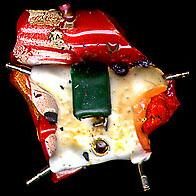 "Requiem" Artifact Just the opposite was the case for my work with the Vox Insecta instrument piece "Threnody To The New Victims Of Hiroshima". This music was inspired primarily by the instrument's sounds: I needed to hear a further orchestration of the instrument as possible through multi-track recording. This instrument is capable of not only abstract insect calls, but voices sounding like choirs, sections of the orchestra and more. Listening to the Vox Insecta's initial sounds I immediately thought of Penderecki's Hiroshima recording and expanded upon the theme as we've come to know it (Hiroshima was not the composer's motivation), honoring and referencing Penderecki in title and program notes.
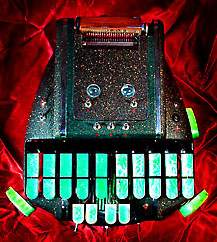 Vox Insecta My work as a nature photographer also played into the music package; the flash-macro (close-up technique) insect shots within the program notes are some of these. In fact, as a hobby entomologist (bug study, that is) I was inspired to finish the Vox Insecta after the local "Dog Day Cicada" (Tibicen canicularis), picking-up coloration and eye placement (antique glass LED lenses) for the final instrument, a heavily-modified Stenograph machine whose stylized insectine body was perfect for the instrument.
 Dog Day Cicada 3) Is the end sound the most important thing, or the process to get to there in creating your instruments - In other words, are you destination-driven or exploration-driven? In the examples above, these compositions were destination-driven as noted -- I wanted to hear/experience something that I could imagine, but that did not exist. With the creation of most circuit-bent instruments, however, I'm after what I cannot imagine... can this still be destination driven? The heart of the chance exploration/design process is reflected here. This search, which ultimately does lead to the sound, a destination perhaps, does become more exploration-driven as this process can be just so astounding, suggesting all kinds of controls to integrate into the design of the final instrument along the way. It's exciting. While the final sounds are why you turn the finished instrument on, it is the mystery and promise of the unknown, the fun even, and certainly the ease of the exploration process that has launched circuit-bending experiments everywhere. 4) On a related note, you illustrate some of the pragmatic aspects of circuit bending on anti-theory with semi-abstract representations (such as the basic Incantor circuit diagrams); how do you visualize sound? Are these representations synesthetic or symbolic?
 Incantor diagram artwork The "stones above the sea" artworks representing Incantor wiring are merely practical. Everything needed to see of the circuit in order to bend it is included; all aspects of the circuit unneeded are discarded. Once the keys to these diagrams are understood, this stylized representation actually reduces confusion and visual clutter, eliminating pin-counting and such on a more standard diagram. Using Photoshop and Bryce to create these representations was fun. I hoped to present something that would not only help Incantor builders, but would be interesting to just look at as well. And yes, I do visualize bent circuitry in this way, a matrix of additions that hovers over or alongside its host. A diving bell or catapult, a separate apparatus for taking the circuit where it could not go before. As to visualizing sound, there is a technique I call "theatric listening". It came naturally to me in the woods as I learned to hear "everything" at once so that the unusual stood out -- a form of "scatter vision" employed by many nature observers, but for the sense of hearing instead of sight. Here sound becomes abstract as do the visualizations of sound in the mind's eye. A near-trance state can be achieved for listening to music wherein the music becomes animated hallucinations, layered and structural, building upon each other and providing textures that more forefront open-eye listening cannot achieve for me. I'm so used to this abstraction that natural sounds are often taken out of context. I find myself surprised at the red squirrel barking beside me though I know the call so well. Writing, Teaching and the DIY Ethic: 5) It's apparent that the DIY aspect of circuit bending is important to you, as you've written at length about it and about your techniques in various forums, and this promotion has obviously helped popularize circuit bending - "a new folk song fills the air" was a quote from another interview you gave. I'm again interested in what you feel the relationship between two aspects of the work is here - the promotion/dissemination/teaching aspect and the actual bending and instrument creation. Is the DIY aspect of circuit bending a logical byproduct of the process, embedded in the ease of entry to anyone willing to pry open a sound making toy and poke at it? Over the years, through circuit-bending, the re-evaluation of the electronic circuit as an open rather than closed entity has resulted in a new instrumentarium too musical to ignore. Viewing these circuits as we do IC's, as modules to elaborate upon rather than as ends to themselves, now makes sense. Like so many other things piled up in our midst that musicians and instrument designers have grabbed up to modify and musicalize, circuit-bending finally opens these doorways to abandoned circuitry. Here the worthless circuit performs as the most fertile platform the art world has ever known: an immediate canvas. These bent circuits can be viewed as a sort of electro-ethnicity. Their new musical response via bending is suggestive of an anthem or a folk ballad of their kind. Circuit-benders are in many ways like anthropologists traveling distant villages, recording native people's song. Indigenous musics can be revealing, even shocking, as they illustrate sensibilities so close at hand yet so far from mind.
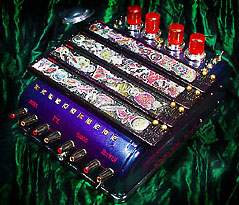 Dworkian Register I see such revelations as important prompts in how we regard the general understanding of music, how we create music and how we listen. Great leaps in art come from artists thinking outside a system. Circuit-bending might allow musical electronics to "think" outside a system, and certainly inspires more artists to do so every day. That is important to me, and is more important than me. I think it's important to art. So I teach it as well as follow it. And really, I couldn't teach it if it weren't for the DIY aspect; I couldn't have learned it myself otherwise. I was about 14 and knew near-nothing about electronics when I stumbled upon it. The ease and musicality of that experience impressed upon me the notion that it was an art destined to happen, and was at the fingertips of anyone who'd give it a try. My discovery process also occurred in the mid-60's. The spirit of the moment was one of sharing; it seemed right to give it away and I haven't ceased since. The thanks I get in all the emails recalls those times very well. 6) Has the self-analysis, record keeping and examination of process required by your writing added to your understanding and the development of your own work? Oh yes. The field is full of questions. I ponder many aspects of this odd art and struggle with definitions. I've had to develop a new nomenclature to express unusual concepts, to illustrate ideas in my writings. This, plus all the circuit diagrams, re-do's and tech notes, further establishes and expands the art continually. Other benders are adding greatly to the field each day. I'm indebted to the good souls I've met. We share a waking field and exchange information like a friendly art lab. It's a great thing. Instruments and Techniques: 7) Do you have a favorite instrument/bend that you've created? Can you pick one out as the most satisfying? That's hard to do! All of the five "essential" instruments are true favorites... Incantors, Trigon Incantors, Aleatrons, Morpheums and Photon Clarinets. But they're the only instruments in my chief category because each represent a different aspect of the art: chance production and interface; musician as live circuit.
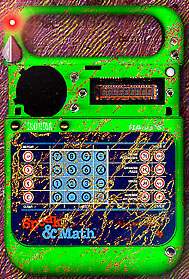 Incantor Incantors, any of the three models (bent Speak&Spell, Read, or Math), show the anti-theoretical yet stunning musical power of circuit-bending very dramatically. Every time one of these instruments is turned on, the musician will, without a doubt, hear new things. Easiest way to accomplish this is to use the looping function... As the instrument is speaking, the "Loop Search" push-button, a circuit-bending addition, is pressed and held. This halts the speech in progress and initiates an audio loop. This loop might contain recognizable bits of human voice (isolated vowel and consonant sounds, fricatives and glottal remnants, segments of the allophone set [electro-phoneme variant] behind the synthetic voice) interspersed with completely abstract noises (musical tones, odd percussive accents, indefinable sounds). Exactly which sounds result from pressing the Loop Search button depends on the split-moment the button is pressed. In this mode the Incantor works as a chance music box, truly fascinating in its endless variations. A loop can be locked into place by throwing the "Loop Hold" toggle switch and releasing the Loop Search push-button. At this point the loop's speed/pitch can be varied with the speed dial, another circuit-bending addition. A kind of sonic microscope results as the sounds are slowed down. The streams of digital information are expressed in intricate detail here as you walk the stick along the picket fence. Very intriguing. Regardless of speed, Incantor looping is extremely musical, as unusual as it may be. For very fine (and hands-free) incrementing of loops I install a photocell behind an antique white milk glass lens. With this "electric eye" turned on, the shadow of the player's hand passing over the eye will step the Incantor from one loop to the next without having to touch the instrument at all. With the instrument running through a fine sound system the voices are strong and impressive. The listening environment is filled with the loop, strange as it usually is and now tweaked with EQ and a touch of reverb, maybe pitched-down and sounding like an involved alien music ensemble. To then simply make a hand gesture in space above the instrument, incrementing forward to the next complex loop, changing the loop just a bit or a great deal depending on the gesture's length of shadow, is amazing to perform, listen to and watch. Incantors also have body-contacts for real-time pitch modulation. Touching these stationary brass spheres with the fingertips induces frequency changes in proportion to finger pressure. Vibrato and other rhythmic expression through pitch change brings further life and animation to the voices. A trill in the high ranges, key shifts in the low, and more. Of course, beyond looping there are many other entry-points into the instrument. The three voice-bending switches, singly or in combination, open another bottomless category of aleatoric exploration. Certain of these settings will again result in loops, but more often the result is a stream of audio events, speech and abstracts, lasting an indefinite period, perhaps seconds, perhaps minutes, perhaps hours. A chance sentence might result here and there. Maybe just tonal gibberish. Most often all of the above, intertwining in unpredictable ways, frequency and speed adjustable as before.
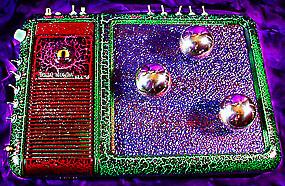 Trigon Incantor The Trigon Incantor, a Texas Instruments speech synthesizer once marketed as the Touch & Tell, is another great experimental aleatoric instrument after circuit-bending. Here three steel balls are the interface; the musician rolls these heavy spheres upon the pressure-sensitive playing stage to trigger responses. Like the Speak&X series, vocal/abstract chance music is the result. Trigon Incantors are perhaps the best at producing on-going sequences of abstract aleatoric music. Body-contact and speed dial, as on regular Incantors, again for pitch adjustments.
 Casio SA2 Aleatron Probably on the same level of interest to me as the Incantors would be the Aleatrons -- polyphonic aleatoric keyboard instruments. Here circuit-bending often releases, instead of mostly abstract output as in the example of Incantors, "real" instrument sounds -- the sampled voices in the keyboard's instrument bank. However, these instrument sets are now, under the pressure of circuit-bending, capable of playing spontaneous arrangements of the most bizarre fashion. Piano, bass, flute and drumset are now conducted by a chance baton; the charts before them filled with notation falling by fortune from the sky like rain. Deep-end Aleatrons, like the bent Casio SK1, offer the best of both realms. Real instrument as well as abstract tone aleatorics. The SK1 is also a sampler; your own signal input can be bent within the system, appearing amidst the other of the keyboard's sonic elements. Such a deep Aleatron will produce amazing waves of sound, shifting curtains of noises, assembling and shredding away into new forms continually. A wonderland.
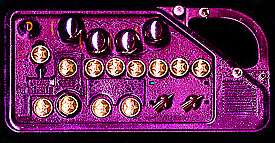 Morpheum The Morpheum is an expressive body-contact instrument. The musician here becomes an active part of the circuitry, conducting electricity through their flesh... another musical Never-Never Land. Animal cries and machine sounds are pitch-shifted in real-time by touching the metallic contacts. An intense alien lead voice is possible here as well as much more. Like your own voice, you can adjust pitch anywhere within range and at any rate you desire. Except now your voice is an elephant or a train track, or any of a dozen such sounds. And the range is from chirp to whale... try this with a lion's roar, your fingertips on the chrome.
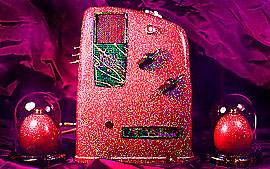 Monolith Photon Clarinet And exactly the opposite, Photon Clarinets, like a theremin, are played without touching. Photon Clarinets produce a sweep-able pitch as the player's hand moves relative to the light sensor on the instrument's left. But the second sensor, to the instrument's right, will step the pitch through arbitrary scales as the hand is moved in space above. This creates a control/non-control atmosphere as the player "riffs" unusual "scales" in the air with the right hand while the left hand tunes these scales or vibrates their notes, gesturing above the instrument. These are my favorites. The deeper, more elaborate one-of-a-kinds can be astounding! The Video Octavox, the Dworkian Register, the Feylith, the Gaiatar. But I reach for an Incantor more often. 8) Are there any type of instruments or approaches that you haven't had the opportunity to work on that you'd like to? Haven't had the opportunity but would like to? Oh, sure. In my personal collection I have many hundreds of interesting instruments from around the world. Experimental & traditional of the planet, old & new. But the time to learn them? To study them and get to know them? I can get intrigued by a buzz kalimba (thumb piano with beads on the tines) as easily as a great synth; a steel cable played by a brook as soon as a tympanum or door hinge. A loose floorboard as soon as leaking boiler as soon as my classic Martin from the 1920's. Sound is powerful, we don't have enough time to hear or compose with it all. Instruments are like books. You'll only have time to absorb a fraction of them. So it comes down to which ones take the individual the furthest, depending upon who they are. Experimental instruments (and arts and sciences in general) have taken me the furthest in broad thought, and certainly in instrument creation and musical composition. But... haven't had the opportunity but would like to? I guess I'd just ask for instruments and techniques that I've never heard of yet. Choosing between things I'm aware of would be simply impossible. 9) Are you still surprised by some of the results that come out of your experiments? Anything look especially promising out of the current wave of music toys hitting the 2nd hand market? I'm still surprised at what comes out of instruments I made decades ago! As noted with Incantors, new musical material to work with appears each time the instrument is activated. Really stunning sometimes. Same with the Aleatrons -- always something new as the bent logic routines interact. As to the on-going design experiments, these are never-ending treasure hunts. That's why I'm still at it thirty-some years later. Each circuit holds the potential of fantastic discovery -- sound-forms simply unattainable anywhere else; musical elements hatched outside conventional theorem. Persons into electronic synthesis will feel the impact of that statement. The surprise factor is stupendous here, likewise, perhaps, the challenge of sensitive listening and composing. Too often circuit-bent instruments are dismissed as toys, or just as something less than "serious" instruments. But I've seen so many synthesists, familiar with the cutting edge of machine and technique, become mesmerized once an Incantor is in hand. Each year I get messages from top-end developers telling me that circuit-bending is the "missing-link" in synthesis technology, and is so on two levels: new sounds of course, but also bringing the fun back into electronic design, including the foundation of all musical circuitry... musical thought. Currently the second-hand marketplace is packed with the best assortment of target circuits ever. I look for, first of all, fine-sounding circuits. This is an indicator of the fidelity potential of the final bent instrument. As time has passed, "toy" audio circuitry has improved greatly. Beyond this I like to find high-quality samples or hi-fi synthetic speech onboard; sampling capabilities even better. One very significant advance in available circuitry would be the proliferation of small to mid-size polyphonic keyboards now appearing here and there in the second-hand marketplace, selling for a few dollars each. Some of these can be turned into dazzling Aleatrons since their bendable circuitry contains very complex (and accessible) synthesis and control routines. The bent Casio SK1 Aleatron is just such an item. The depth and spread of its new output is tremendous.
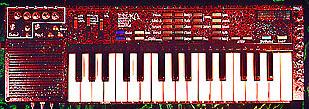 Casio SK1 Aleatron [ed. note - Ghazala's how-to article on bending the Casio SK1 is currently available online.] Right now in the second-hand shops, flea markets and yard sales you can find such circuits where not that long ago you'd find little more electronics than broken transistor radios. These are the best times circuit-bending has known as the landscape is thick with high-quality circuits, and musicians are looking for ways to experiment beyond the norm. Circuit-bending operates on several different levels here, offering alternative tools for artists to interface with as well as new sounds for composition. They're not for everyone. But their time has certainly come. I think it will be interesting to see how things go as we re-evaluate the electronic brain, giving it a dose of those character-building mishaps that influence our own cerebral identity, our personality and creative output. Background: 10) Your bio emphasizes the fact that you're self-taught, in electronics, music, and visual art. Did you take inspiration from any particular composer, artists, movements along the way? Oh sure. I'm curious and excitable. I dig for things, though outside the halls of formal institutions. They didn't work for me. In electronics I was too young anyway. I stumbled onto circuit-bending at fourteen. It taught me. Music and visual art -- I was much younger still. Just followed my projects. They demanded material, technique, so-on. The same today. In my teens I raided the public library's experimental music collection for a year. Subotnick, Xenakis, Cage, Ussachevski, Penderecki. Liked some of it, not all. Found work by Partch and other eccentric musicians in the local "experimental" sections of the small record shops. Cut-out bins of "ethnic", "avant garde" and "world" music slots. I realized other people thought about sound the way I did, as an open field beyond the equal-tempered scale. I've always liked unusual audio. Created it as a child in various ways; had enchanting dreams about it as a little schoolboy, long before I knew it existed as a recognized field. I used to go around the neighborhood with a big hammer, maybe I was six years old or so, hitting telephone poles as hard as I could and immediately pressing my ear to them, splinters and all. People thought I was nuts. But try it! Unusual kinetics, arts that present in suggestive abstract or complete abstract, arts that cannot be identified, existing as mirage through lighting or angle, pyrotechnic, smoke or liquid art all have moved me. Usual names come to mind. But equally the odd solar art I saw in the MOMA as a child on vacation in NYC created by an artist I was too young to realize even existed. Lots of that in passing. The father of a friend of mine, when we were little kids, had a high-frequency electronics lab in his basement. Van de Graff generators, tesla coils, that kinda thing. He'd wave fluorescent tubes in the air around the apparatus in the dark, the tubes glowing brightly without a wired connection. Or a spinner would be balanced on the tesla needle, its ends neon-blue with an ion wind as it rotated. This was art. But as to a movement? The psychedelic art of the 60's was certainly an influence. Not just the art. The overall conceptual influence of the times could be seen changing the country's landscape daily. I was in my mid-teens and it permeated my world. I partook of everything the times prescribed. The whole thing was an art trip. Mind as medium. In the art world at ground zero, where kids like me were, 3-D lenticular art swirled and rushed out at you from the frame. Fluorescent "day-glo" colors hit artist's canvas for the first time. Hard to imagine a world without day-glo now, isn't it? Pretty big thing then though -- a paint that magically seemed to light-up was something! Mechanical colored and white xenon strobe lights of all sorts, endless artworks to be lit by these covering the walls, plus blacklights, lightboxes and color organs and incense and sculpture and music and! ...all became common-place in teenager's rooms where for years prior the mood had been set by a model car, a baseball trophy or a teddy bear collection. This jump into the common psychedelic art experience, happening everywhere, was a pretty impressive thing! Couple it with a very strong sense of solidarity in the grand experiment at street-level and, yes, it was a movement that had influence everywhere in art, in lots of my world. Moreso, beyond any of this, as all of these things have come and gone, I more steadily experience the phenomena of the planet by visiting the forests when I can, watching the world from there. That's how I started life, growing up on the edge of a small woods.
 Ghazala' Music Tent I collect books on unusual science. I study plants and animals, weather and stars. I travel with a microscope, cameras, telescopes, topographic maps, field guides of all types, current star charts I print at home, kites to feel the wind, all that. Nature observation has shaped my emotions deeply as to how I feel about composition. Impressions here have struck me much harder than any individual, artwork or movement. There is an essence I sense here, not only reflected in the assembly of my work, but in the expression behind it. I've wondered in what way this leaning might be retrograde though I sense a vital forward progression in understanding and creative inertia. The balance of life in the forest. The spirit. The natural art! The formation of flotsam sculptures I've seen at the tidelines, the weather and sky effects, aurora and spectra of the atmosphere, the chance patterns everywhere, and all the other obscure, intense observations that can only be witnessed in nature, an art unfelt now by so many. These phenomena effect me emotionally. I can't separate these things from my tools in my art; it's all there. Might sound odd, but exploring a forest is a lot like circuit-bending. An experience of delightful discovery, of intense insight. Of shock and confusion. Of profound revelation. An exploration of theme and form so deep you can drown in it. And I sure do. 11) The documentation on anti-theory.com indicates mail art and the Cassette Mythos are some points of reference along the way.. Who do you view as contemporaries and peers in your work? You mentioned John Hajeski, for example, in some recent writings. Cassette Mythos, a wonderwork of Robin James, is how I, and many other sound-art people, began to better network with each other. The Mythos Project put people in touch. Robin James is a field hero. The Mythos archive of text and music (cassettes and CDs) is superb. John Hajeski and I have been in touch on and off since I began writing for EMI (Experimental Musical Instruments magazine) in '92. John began his exploration into the creative short circuit back in the mid 60's, same as me. John's done work with Busy Ditch and the "Portable Anarchy" instrument. He's also the first performing bender I ever corresponded with. Significant work in bent instrument design and composition is being done by many persons now, a bunch of whom I'm in touch with. Rather than try to do a fair job on that list, I'd suggest a web search on the key terms. People will find many instruments to see by different artists, and differing takes on it all. The field is diversifying and there are some extremely interesting things happening as sound artists discover their own new designs. 12) Your contact information lists your residence as being in Ohio - are you originally from the midwest? Do you think your location as slightly removed from the East coast/West coast cultural poles in the US has had an impact on your work? (And I ask that as someone born and raised in Michigan..) Or do you feel that the context of location is irrelevant to what you're doing? I'm an Earthling. That means more to me and is very relevant. The moods of cities, their "art climates", are just fine. Fantastic sometimes. I know people on both coasts doing really great work, music and visual. I'm from the midwest. I've had great moments in the world's big cities, London, Paris, NYC, etc., and the obscure out-of-the-way places... horseback in a rain forest, speaking with witches in elegant abandoned cemeteries, running with wild elk in the mountains and speculating with great madmen in astounding places. But I desire to return to the woods, the plants and animals that I know, and my workshop here, and back to the experiments.
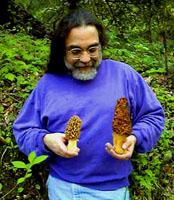 Ghazala After a Sucessful Mushroom Hunt I'm really out of touch with the trends, East, West, or other. I never considered it geographic. I've been out of touch as long as I can remember! It was a problem as a kid. Wasn't interested in sports. Nor school groups or studies. Boring. I was a misfit. I had counselors. No one knew what was wrong. I got tested. Dropped out of every school I ever attended. Even art school where I was really supposed to be interested in the given pulse of things. I just wasn't. The midwest is a resource center for me. It's actually rich with materials. There's even a mini-exodus from the coasts to the midwest for the creation of art studios and living spaces. Artist "colonies" are springing up in the less expensive and fertile folds of the midwest, in the farmland and the forests, in the river valleys. Too, internet exposure has many artists reconsidering the importance of actual geography. Performance artists might have more difficulty, but artists such as myself who are studio- rather than city-based can exist where their resources are. Getting the art "out there" is now easier. And realistically, my time is spent in off-beat places. The ethnic restaurants and whole food stores. On a rooftop with friends. Flea markets. Industrial auctions. And the second-hand stores where I'm influenced by hi-tech internationally-manufactured rubble, not on the sofa reading the newspaper. Or I'm in the woods influenced by snow and fire, by birdsong and ice cannon, not in the smoky city bar. I'm just too busy with experiments to be very susceptible to geographic social trends, here, there or elsewhere. I've never worried about my art "fitting-in" anywhere. Requests I'll go to the ends of the earth to fulfill. But my original art I do for me, so I can see/hear/experience it. To see if it works. To see where it will lead me next. That's all. Often in the same spirit I'd set unusual liquid mixtures out in the winter cold for... to see how they'd solidify, if they would at all, and how they'd look either way. Performance and Composition: 13) Many circuit-bent instruments are only partially controllable and/or predictable in behavior - you elude to this fact even in the names of the Aleatrons, for instance. What are your thoughts about the man/machine, artist/instrument, composer/sonic material relationships that are encouraged by this situation? Are you performing "with" the instruments, rather than "on" them - improvising with a non-human partner? Composition is extremely important to me, a puzzling position it might seem in the realm of aleatoric instrument development. But streams of sounds have emotional impact, thereso they can be considered as compositional elements the same as any sound, note or color. And what is composition? Or for that matter, what isn't a composition? Anything? Who composes the sound of wind chimes? Or of wheels on a train track? Perhaps musician steering composition in the way a breeze might stir chimes presents problems; certainly if we're to judge through traditional eyes and ears. Yet still, like every color, every sound elicits an emotion. Thinking outside the notion of "high music" seems the only way to address (and musically resolve) the emotional impact of things possible beyond the 12-tone palette. Most of the sound of the world is here. Composing with aleatoric music is part of this challenge. If we can accept that ambient sonic environments can have fine emotional impact, then we are well on the way. Here, in a live performance, the chance elements of several aleatoric instruments might stand on their own. They might in combination produce, untouched, an interesting live composition. But what happens when the human musicians enter the act? Now there's a person monitoring each instrument's output, deciding when it should enter and exit the mix. Deciding if output should be effected, re-started, pitch-shifted, panned, EQ'd, or changed in various ways depending upon the instrument and sound system. Solos, harmony, refrains, themes, measures and movements... all the traditional modes of structure can still be addressed here. If that's what's wanted. Many very interesting musical arrangements can be explored by combining more traditional instruments with circuit-bent. For example, a good chance loop, repeating itself at regular intervals, could be established on an Incantor. Sensitive to the loop's odd rhythm, its unusual pitches and sounds, musicians with continuous-tone instruments (i.e., non-fretted and non-stopped instruments like violin, cello and bass viol, wind and percussion examples, human voice, theremin and synths, many world instruments) could play along in the same way as might be expected within a more traditional improv ensemble. A "key" (or set of pitches) would be established, a meter, and these would be worked with in the traditional sense. A fine jazz drummer playing along with an intricate, alien loop is amazing in itself. There's lots of room here. If the musicians are monitoring the loops (earphone) before they appear in the house mix (loop player sends), then musicians in sequence can begin to respond to the loop yet to appear to the audience, creating an interesting musical transition. More traditional structure could be had by retaining a certain loop or two, unchanged, to be brought into the mix as a chorus might appear, elaborated upon, and on and on along these standards of the recall/expectation response expected in much music. The psychology behind the "hook"; the musical "fix" is here. The sonata, in a sense. Twelve-tone instruments (many of which can be pitch-bent anyway) can also work alongside aleatoric output. But why not look everywhere altogether? Why not trigger complimentary, non-"musical" sounds that add to the theme instead? Use sample players instead of traditional instruments. Or, as before, just let bent instruments play unattended, like wind chimes, and listen. 14) In your Perfect Sound Forever interview, you mention that one of the advantages of performing with circuit bent instruments is that they result in a "new head space for the artist". Do you feel that these instruments, because of their unusual origins, sonic products or playing techniques are also engaging for the audience - perhaps putting them into more of a "new head space" than traditional acoustic or electronic instruments? Obviously some could even encourage new forms of audience/artist interaction, such as the dancer-manipulated video Octavox that you've described. "Engaging" and "new head-space" may not be synonymous! But certainly with an audience who knows there's to be a new music happening, many things are possible. My own work might complicate matters. I've been called a romanticist. Since I've spent so much time on pine needles, at fireside and lake shore, I understand Wordsworth and Frost, but also the metropolitan. I see this as trail and track of the same creature. I don't see opposing forces here at all, regardless of style. Maybe that's a new head space. Where circuit-bending, chance music, and hi-tech surplus can reveal patterns intrinsic to blind nature pre-historic, and be considered, addressed, and composed with romantically. I have no difficulty in feeling this fragile notion, and in seeking it, expressing it in my adventures regardless of the origins or personalities of my tools. We are living in the midst of a great extinction event, the most intense since the downfall of the dinosaurs. It is true: everything's going away... the plants, the animals, all of it. It's all going away. Maybe you have to know these things, the plants, the animals, the forests, to care. I'm at a loss to find anything more moving than this in our world. It has to be in all my work, theme or not. I care about these things. I'm an activist. I couldn't turn it off if I tried. I guess that's a head space more difficult than just accepting aleatoric music! But that's just me; how I feel. All kinds of compositions are being attempted with these devices. You don't have to view bent instruments beyond their unusual output to appreciate them. They're a new bird in the woods. And as said, just too musical to ignore. They state their own importance and establish an understanding person-to-person, like all instruments. And technically, their output is diverse enough to sustain an incredible spread of ideas. Not that the art is poised to replace mainstream commercial music! But things are happening. It is exploding, and many more music audiences are ready for the new than ever before. Circuit-bending is very powerful and people are taking notice. Current and Future Plans: 14) Any current projects or upcoming plans that you'd like to discuss? Oh, there's always a lot going on. Mark Mothersbaugh (DEVO, etc.) and Nine-Inch Nails' keyboardist are looking for/playing Incantors. Always interesting to see where different styles take the sounds. I'd like to see a fully-bent DEVOesque ensemble! Hasn't been done yet. Would take a LOT of work -- challenging thought and composition. Bending workshops are being discussed and arranged, even for kids, around the country. Please write me for more on this. Various colleges report to me that students are being directed to my how-to (onsite) for work in music classes. This happens internationally as people visit the site and as the writings are translated and printed in all kinds of journals, technology to art to sociology. Classes look for free "cyber professors", find anti-theory.com, and I suddenly have students emailing me from all over the planet. Funny world! Most of my family were teachers. I certainly never thought I'd be, at least in this capacity. It's hard to handle though the web site has made things easier (artists get the info directly now). People should still write with questions outside the on-line how-to if they like. Again toward the same ends, my twenty EMI articles, slowly but surely, are being re-edited and re-illustrated for publication on-line. Many instruments are covered in this series, a great deal of which will prompt DIY experiments and the birth of more instruments worldwide (the street-level art has spawned the creation of thousands of instruments already, more all the time). I hope, somewhere down the road, to find a strong publisher interested in a book/CD package containing the articles, instrument galleries, the how-to, and interactive music disc. With lenticular art of the instruments. On-line, the sales section is being re-done and will now include twenty-five of my bent or original experimental instruments, five times the previous. To answer a common request I've also started a "bare bends" service wherein a person sending me the target device (Speak & Spell for example) gets it back unpainted, but bent to my best specs. The across-the-board price for this will be $350 and will involve five instruments: all three Incantors (Spell, Read and Math), the Trigon Incantor (steel-ball Incantor), and the SA2 Aleatron (chance music keyboard). I do routinely get reports of other designer's bends failing in the field. Especially with Incantors. This is to be expected; it happened to me too until all the circuit variants in the different series become familiar (Speak and Reads, for example have five main variants, all with different wiring needs). The wrong bends, or some bends switched on in combination, can eventually fry an instrument. I've now decades behind the many designs I offer. The bare bends series will represent a super-stable, fully-functioning and economical bent instrument collection for persons to work with. Anyone interested can see more by following the sales section onsite. Bare bends will be at the bottom of the first screen. The sound files are being accumulated for the site. Just tons of work lie ahead here -- most requests are for the EMI articles. But all things are moving along. The DIY circuit-bending section of anti-theory.com is always popular. It's here I'd like to direct people, whatever interest they may have in my inventions. Many folks are stunned at the simplicity of the process and, never having thought they could design electronic instruments, find themselves doing it overnight. Those are nice reports to get. That's really what my site is all about. And just a note to benders and benders-to-be: if you find something at anti-theory.com that you use and that you enjoy, please consider donating a little time to your local animal interests. You know, rescue or feed a stray, look for the lost pets you see in the flyers... speak out against cruelty. There's no thanks I'd like better. I bow deep to you. THANK YOU Eric, for giving me the opportunity to further confuse the world of music. And thanks to all the new benders into it. You're charting the art's future with me; your comments are always read with real interest. All questions emailed here are answered the best I can; please feel free to ask away. Related Q. R. Ghazala URLs: Knock at Ghazala's front door: Circuit-bending how-to: Inside the Anti-Theory Workshop: Perfect Sound Forever interview (USA): Sound On Sound interview (UK): Music reviews: Music retail, Realization Recordings: Soundfiles, Theremin/Ghazala page (in Italian): Experimental Musical Instruments Magazine Ghazala's Favorite Lenticular Art Lab: Additional Circuit Bending-related links, information, and mailing
list:
|